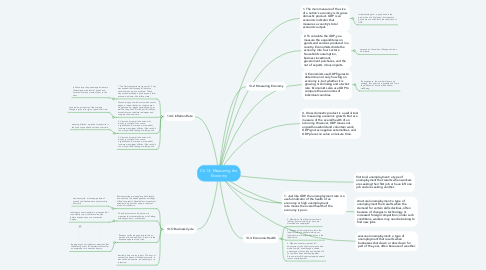Ch.13: Measuring the Economy
by Connor Beckman

1. 13-4: Inflation Rate
1.1. 1. The German experience was proof, if any was needed, that runaway inflation can send an economy into a tailspin. That is why economists keep a close eye on a third economic indicator: the inflation rate.
1.1.1. inflation rate: the percentage increase in the average price level of goods and services from one month or year to the next.
1.2. Consumers pay nominal costs with nominal wages, or wages based on current prices. As prices go up, wages generally go up as well. By using the CPI to adjust for inflation, economists can calculate real wages and compare them over time.
1.2.1. price index: a measure of the average change in price of a type of good over time.
1.3. A dramatic increase in the amount of money in circulation can cause hyperinflation. But even a more modest increase may trigger inflation if the result is too many dollars chasing too few goods.
1.3.1. creeping inflation: a gradual, steady rise in the price of goods and services over time.
1.4. A dramatic increase in the amount of money in circulation can cause hyperinflation. But even a more modest increase may trigger inflation if the result is too many dollars chasing too few goods.
2. 13-5: Business Cycle
2.1. Business cycles are irregular in both length and severity. This makes peaks and troughs difficult to predict. Nonetheless, economists attempt to do just that, using a variety of economic indicators.
2.1.1. business cycle: a recurring pattern of growth and decline in economic activity over time.
2.2. Coincident economic indicators are measures that consistently rise or fall along with expansions or contractions.
2.2.1. leading economic indicators: measures that consistently rise or fall several months before an expansion or a contraction begins.
2.3. Business cycles are popularly known as periods of boom and bust. A boom is the expansion phase of the cycle.
2.3.1. lagging economic indicators: measures that consistently rise or fall several months after an expansion or contraction begins.
2.4. Inevitably, boom turns to bust. The bust, or contract-ion phase of the business cycle, is also called a downturn, a downswing, or a recession.
3. seasonal unemployment: a type of unemployment that results when businesses shut down or slow down for part of the year, often because of weather.
4. structural unemployment: a type of unemployment that results when the demand for certain skills declines, often because of changes in technology or increased foreign competition; under such conditions, workers may need retraining to find new jobs.
5. frictional unemployment: a type of unemployment that results when workers are seeking their first job or have left one job and are seeking another.
6. 1. Just like GDP, the unemployment rate is a useful indicator of the health of an economy. A high unemployment rate means the overall health of the economy is poor.
7. 4. Gross domestic product is a useful tool for measuring economic growth. But as a measure of the overall health of an economy, However, GDP leaves out unpaid household and volunteer work, GDP ignores negative externalities, and GDP places no value on leisure time.
8. 3. Economists use GDP figures to determine not only how big an economy is, but whether it is growing or shrinking and at what rate. Economists also use GDP to compare the economies of individual countries.
8.1. life expectancy: the number of years, on average, that a person is expected to live; a key indicator of a nation’s health and well-being.
9. 2. To calculate the GDP, you measure the expenditures on goods and services produced in a country. Economists divide the economy into four sectors: household consumption, business investment, government purchases, and the net of exports minus imports.
9.1. net exports: the value of all exports minus all imports.
10. 1. The main measure of the size of a nation's economy is its gross domestic product. GDP is an economic indicator that measures a country's total economic output.
10.1. intermediate good: a good used in the production of a final good; intermediate goods are not included in the calculation of GDP.
11. 13-2: Measuring Economy
12. 13-3: Economic Health
12.1. 2. Members of the labor force who are jobless, but are looking for work, are classified as unemployed.
12.2. 3. Everyone who is eligible to be in the labor force but is neither working nor looking for work is classified as not in the labor force.
12.3. 4. When an economy reaches full employment, jobs exist for everyone who wants to work, even though a certain percentage of those jobs and workers will not yet have been matched together. Economists call this percentage the natural rate of unemployment.


